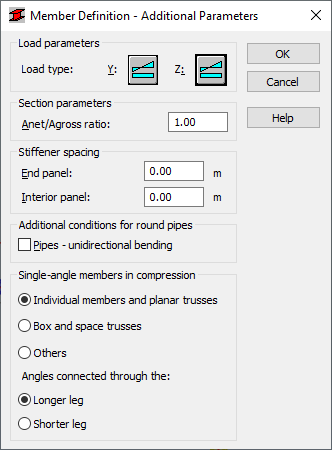Use this option to define additional code parameters for the steel member type according to the CAN/CSA-S16.1-94, CAN/CSA-S16-01 + Supp. No.1 (2005), CAN/CSA-S16-09, and CAN/CSA-S16-14 codes. Access the parameters by clicking the More button in the Member definition - parameters dialog.

The following parameters are defined:
- Load type for directions Y and Z.
- Section parameters
- Anet/Agross ratio. This value applies to a tensile force acting on the cable. It is a coefficient that defines the relationship of the member cross-section area, not considering the bolt or rivet openings (Anet), to the total cross-section area (Agross).
- Stiffener spacing for the outermost and intermediate panels.
- Round pipes case conditions. If the Unidirectional bending of pipes option is selected, then, for this type of section, a bending moment equal to a sum of moments operating along axis Y and Z is calculated; the resultant moment is the basis for bar design.
- Single-angle members in compression (see
Section 13.3.3
of the code).
By selecting an option from this field you can define a function of single-angle members in a structure and how they are connected with gusset plates. Depending on a selected option, Robot calculates the equivalent slenderness of the element in compression according to Section 13.3.3. Thus calculated slenderness will be used for the buckling check for the directions Y and Z.
- Individual members and planar trusses
- Box and space trusses
- Others - If this option is selected, single-angle members are analyzed according to the general rules specified in Sections 13.3.1 and 13.3.2.
Note: The options concerning Single-angle members in compression apply only to angles defined in the parallel axis system. Angles defined in the principal axis system are analyzed using the general method given in Section 13.3.2 of the code.
- Angles connected through the: longer leg or shorter leg. Use this option to specify how an angle is connected to the gusset plate.
